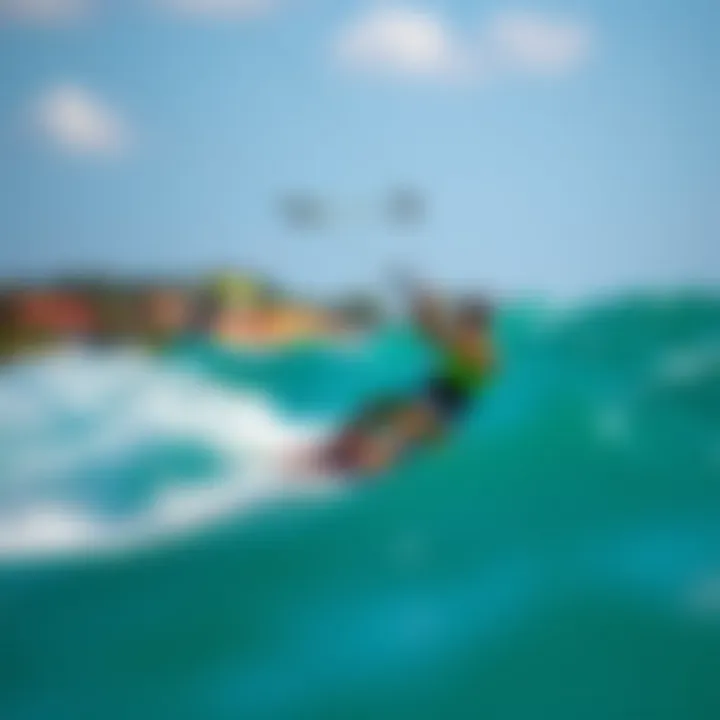Kitesurfing Travel Insurance: A Comprehensive Guide


Intro
For anyone who has ever felt the rush of the wind in their hair while dodging waves on a kitesurf, the experience is electrifying. However, alongside the joys of kitesurfing come a myriad of risks that can turn an exhilarating adventure into a daunting ordeal. This is where kitesurfing travel insurance steps in, acting not just as a safety net but also as an essential companion for any kitesurfing enthusiast.
Understanding the intricacies of life on and off the water is crucial. While the thrill of the sport draws many into its embrace, it is important to recognize that accidents can happen. Whether you are a novice learning the ropes or an experienced rider seeking out the next big wave, having the proper coverage ensures that you can tackle your goals without the lingering worry of financial repercussions.
In this guide, we will explore the detailed elements surrounding kitesurfing travel insurance. We'll navigate coverage options available, delve into risks associated with the sport, and highlight practical advice for both travelers and riders.
From our discussions, you will gain insights into:
- Risks and considerations that are specific to kitesurfing
- How to select a policy that fits your unique needs
- Notable case studies showcasing the importance of being prepared
As we embark on this exploration, remember that the waves can be unpredictable, but a well-informed kitesurfer is always prepared to face what comes their way.
Importance of Travel Insurance for Kitesurfing
Travel insurance can turn out to be a lifeline for kitesurfing adventurers, who face unique risks while catching the wind and waves. When you're planning a trip that involves high-octane activities like kitesurfing, having the right coverage is just as critical as the gear you pack. Travel insurance serves as a safety net against unforeseen circumstances, which can ruin your hard-earned getaway.
Understanding the Risks
Kitesurfing, while exhilarating, comes with its share of risks. Strong winds, unpredictable weather patterns, and other external factors can lead to accidents or injuries, ranging from minor scrapes to serious incidents. Add to this the potential for equipment damage or loss, and the need for insurance becomes more apparent. Riders must consider various scenarios:
- Personal Injury: Crashes or falls can happen, even with experienced riders. Injuries might necessitate medical attention—potentially in a foreign country.
- Equipment Damage: Kites, boards, and harnesses can easily be damaged by rough waves or accidents. Replacing gear abroad can be quite a hit to the pocketbook.
- Natural Disasters: Unexpected weather changes can end a trip abruptly, leading to costly cancellations and changes in travel plans.
Having travel insurance isn't just a wise choice; it transforms a risky adventure into a safer experience. Coverage can provide peace of mind, allowing you to focus on the water instead of worrying about what could go wrong.
Statistical Overview of Kitesurfing Incidents
Looking at the numbers, some may find the statistics eye-opening. Reports indicate that kitesurfing accidents occur more frequently than one might expect, especially in locations known for their vibrant kitesurfing communities. According to a study referenced on britannica.com```, the injury rate among kitesurfers can be as high as 3 per 1,000 participants each year.
- Types of Injuries: Over 50% of these injuries range from sprains and strains to more severe accidents involving dislocations or fractures.
- Equipment Issues: Approximately 20% of kitesurfers report damaged equipment during a session, emphasizing the importance of having coverage for gear against theft or damage.
These figures illuminate the risks involved and underscore the necessity of securing proper travel insurance. Whether hitting the waves in Maui or chasing winds in Brazil, understanding these risks allows riders to make informed choices about their travel insurance policies.
Types of Coverage Available
When you embark on a kitesurfing trip, the thrill of the waves and the wind dance across your sail provides an undeniable rush. However, navigating the waters without adequate insurance coverage can turn that joyride into a nightmare. Understanding types of coverage available is crucial for ensuring peace of mind as you chase the perfect wave.
Medical and Emergency Evacuation
The heart of any travel insurance plan lies in medical coverage. Kitesurfing, while exhilarating, carries its share of risks. Accidents can happen — from minor injuries like cuts and bruises to serious incidents requiring immediate medical attention. A solid policy should cover:
- Emergency medical expenses
- Hospital stays
- Ambulance fees
In more extreme cases, having emergency evacuation coverage can be a lifesaver. Imagine needing urgent medical assistance hundreds of miles from the nearest hospital. This coverage ensures that you can reach qualified medical personnel swiftly, possibly via helicopter if you find yourself in remote locations. Without it, the costs can be astronomical, leaving you grappling with bills that can match your travel expenses.
Equipment Coverage
As a kitesurfer, your gear isn’t just your ticket to enjoyment; it’s a significant investment. Thus, equipment coverage shouldn’t be an afterthought. These policies cover:
- Loss or theft of your kitesurfing gear
- Damage during travel
Picture this: you arrive at your kitesurfing destination only to find your board has been damaged in transit. This coverage can save you from shelling out money for repairs or replacements that could run into hundreds, if not thousands, of dollars. It gives you the confidence to kitesurf without the lingering worry of watching your gear closely like a hawk.
Trip Cancellation and Interruption
Life is unpredictable, and sometimes plans fall through. This is where trip cancellation and interruption coverage steps in. Incidents such as:
- Illness
- Family emergencies
- Natural disasters
can all derail your travel plans. Without this coverage, you might lose the money paid upfront for flights and accommodation. Having this safety net allows you to recuperate some of those expenses and reschedule your epic trip without feeling like you've flushed your money down the drain.
Liability Coverage
Liability coverage often gets overlooked yet is essential. This type of insurance protects you in case you inadvertently cause damage or injure someone while kitesurfing. In crowded waters, a small collision could create larger consequences. Liability coverage typically addresses:
- Legal fees
- Damages awarded to another party
If an unfortunate incident occurs and a fellow kitesurfer ends up injured, this coverage could prevent you from facing financial ruin. Without it, one accident could have you up the creek without a paddle.
Having a comprehensive understanding of these coverage types not only safeguards your financial interests but also allows you to enjoy your kitesurfing adventure with confidence. Protect your passion and prioritize the right insurance coverage to minimize risks while maximizing the experience.


Selecting the Right Policy
When it comes to ensuring a safe kitesurfing experience, picking the correct travel insurance policy is paramount. With various layers of risk involved in kitesurfing, understanding what your policy covers ensures peace of mind on and off the water. Different policies offer varying degrees of protection, so knowing how to select the right one can mean the difference between a worry-free trip and a potential financial burden.
Assessing Your Needs
This is the first step in your journey to find a policy that suits you best. Every kitesurfer has unique requirements based on their personal circumstances, health status, and travel plans. Are you a novice or an experienced rider? Do you participate in competitions or simply enjoy a leisurely kitesurfing session on a serene beach? Identifying your activity level and how often you plan to kitesurf can make a significant difference in what coverage you should consider. Always take a moment to reflect on your own situation, including:
- Your health history – Any existing medical conditions can complicate matters.
- The locations you'll visit – Some places might pose higher risks than others.
- The duration of your stay – Longer trips may warrant more extensive coverage.
Key Factors to Consider
The decision-making process doesn’t stop with your personal needs; there are several factors that should guide you in selecting the right policy.
Destination Considerations
The specific area where you plan to kitesurf can dramatically impact your insurance needs. Each destination comes with its own set of risks, whether it be strong currents, rocky shorelines, or local wildlife. Familiarize yourself with:
- Local conditions – Is the water calm or turbulent? Are there prevalent weather patterns such as storms or high winds during your visit?
- Healthcare availability – Make sure you know if quality medical facilities are nearby, and what the process for emergency services looks like in that location.
Understanding these nuances helps frame your insurance goals and ensures that you’re not caught off guard should an accident occur.
Duration of Coverage
Another critical aspect to consider is how long you’ll need coverage. Depending on your trip’s length, you may want:
- Short-term plans, particularly for quick excursions; or
- Long-term policies, if you’re seeking a multi-trip option that can cover several kitesurfing adventures throughout the year.
The duration of your coverage should reflect your travel plans. Always read through the terms to ensure that your policy can accommodate any extensions in case your trip runs longer than expected.
Activity-Specific Clarity
Let’s not overlook the fact that not all policies are tailored equally. Some may specifically cater to adventurous activities, while others may have general outdoor activity clauses. This distinction can be crucial for any kitesurfer. You should seek:
- Clarity on kitesurfing coverage – Does your policy explicitly mention kitesurfing under its list of covered activities?
- Potential restrictions – Are there any stipulations regarding competition events or specific equipment?
Having this understanding allows you to avoid unwelcome surprises when it comes time to file a claim.
"Selecting the right insurance policy isn’t just about ticking boxes; it’s about tailoring protection to match your unique kitesurfing adventures."
By taking a meticulous approach to selecting your travel insurance policy, you’ll be setting the stage for a smooth kitesurfing experience. Allying your needs with the right policy features can enhance your sense of security, making your time spent riding the waves much more enjoyable.
Common Exclusions in Kitesurfing Insurance
Many kitesurfers may grab a travel insurance policy without delving into the nitty-gritty. However, recognizing the common exclusions is vital for making informed decisions about coverage. Knowing what’s not covered can save you from financial headache and unwanted surprises at the worst moment possible. After all, the last thing you want when you hit the waves is to find out that your insurance doesn’t have your back in a crunch. So let’s explore the essential exclusions that kitesurfers need to be aware of.
Pre-Existing Conditions
When it comes to travel insurance, pre-existing conditions often create quite a fuzz. If a health issue is something you dealt with prior to your trip, many policies might not cover any complications or emergencies arising from that condition. For instance, let’s say you’ve had knee surgery a few months before, and on a windy day, you take a tumble while kitesurfing.
If you need medical care, your policy might refuse to cover it because of that pesky pre-existing condition. This could leave you footing a hefty bill at a hospital—or worse, abandoning your trip altogether. Therefore, it is smart to evaluate your health history and check with the provider about what conditions may exclude you from receiving help during your travels.
"Ignoring pre-existing conditions can lead to a costly wake-up call!"
Extreme Weather Events
Anyone who has spent time on the water knows that weather can shift faster than a kite changes direction in the wind. Some insurance policies won’t cover damages or injuries that occur during extreme weather events like hurricanes, storms, or high winds. Imagine this: you're excited to ride the waves, only to find the forecast has turned dour. If you decide to go out anyway, thinking you can handle the conditions, any accidents or issues that arise could leave you without insurance support.
It's crucial to stay updated on local weather patterns and forecasts while at your kitesurfing destination. Being aware means not just keeping your eye on the sky, but also ensuring that any potential problems with insurance coverage are addressed before you get on the water. Always read the fine print and discuss any concerns with your insurer to protect yourself against falling victim to weather-related exclusions.
Travel Insurance Providers: A Comparative Analysis
Travel insurance serves as a fundamental pillar in the realm of kitesurfing adventures, not merely acting as a safety net but also providing peace of mind as enthusiasts chase the wind around the globe. As different kitesurfing destinations come with their own unique challenges and risks, having the right insurance can mean the difference between a stress-free trip and a potentially disastrous one. It’s crucial to perform a thorough comparison of travel insurance providers to ensure that specific needs are met.
Leading Providers Reviewed
When sifting through insurance options, a few names consistently rise to the top. Each provider offers something slightly different, addressing various traveler requirements:
- World Nomads: Known for their extensive coverage, they cater specifically to adventure enthusiasts. They typically cover many water sports, including kitesurfing, making them a solid choice for thrill-seekers.
- Allianz Global Assistance: Their plans are incredibly versatile and often include necessary medical amenities. With a reputation for comprehensive customer service, they help travelers navigate tricky insurance claims efficiently.
- InsureMyTrip: This site offers a convenient platform to compare various plans from different providers. Travelers can customize their coverage based on budget and needs, perfect for those who want to tailor their insurance to match specific trip aspects.
- Travel Guard: Renowned for its trip cancellation policies, Travel Guard provides robust coverage for kitesurfers who may face unpredictable weather or changes in travel plans.
In considering providers, kitesurfers should review not just the coverage offered but also the ease of making claims. A provider, no matter how great their coverage sounds, is only as good as their claims process.


Pricing Structures and Coverage Limits
When it comes to pricing structures, expect a broad range depending on the coverage limits and the types of activities included. Some key takeaways include:
- Standard Plans: Plan prices typically start around $40 to $100 for a week, though this can vary widely based on activity level and destination.
- Adventure Add-Ons: Some insurers offer additional options for covering risky sports, which may cost around $25 to $50 more. If your plan doesn't include kitesurfing by default, it’s crucial to add this to avoid claims denial in case of an incident.
- Coverage Limits: Basic plans might cap medical expenses at $50,000, while premium plans could go as high as $1 million. Keep in mind that kitesurfing can land you in situations not covered under basic medical packs. Always read the fine print here.
- Deductibles and Exclusions: Expect deductibles that range from $0 to upwards of $500. Pay attention to what is excluded; common exclusions might include injuries resulting from reckless behavior or non-compliance with local kitesurfing regulations.
Understanding each provider’s coverage limits and pricing structures is essential in ensuring that you get the most bang for your buck, especially when it’s about risky and exhilarating sports like kitesurfing.
By conducting a detailed analysis of travel insurance providers, kitesurfers can feel assured that their investment in gear and adventures is protected. Ultimately, the right policy can provide valuable support and minimize obstacles, allowing riders to focus on the joy of the wind and waves.
Real-Life Case Studies
Real-life case studies serve as vital learning tools in understanding the intricacies of travel insurance in kitesurfing. These narratives highlight the unpredictable nature of adventure sports and provide kitesurfers—both novices and veterans—with concrete examples to reflect upon when selecting their policies. By examining firsthand experiences, riders can better grasp the essential elements of coverage, thus making informed decisions that enhance safety and peace of mind.
Success Stories of Coverage
When you look at success stories related to kitesurfing insurance, it’s clear that a well-chosen policy can make all the difference. Take, for instance, the case of Sarah, an avid kitesurfer in her thirties who decided to travel to Tarifa, Spain. Excited to catch the winds, she invested in a comprehensive travel insurance policy that included medical evacuation and equipment coverage.
One afternoon, while riding a particularly powerful wind, Sarah fell and dislocated her shoulder. Thanks to her insurance, she was airlifted to a local hospital, where she received prompt medical attention. The insurance not only covered her medical bills but also the cost of temporarily renting equipment while her own was out of commission. This experience saved her not only expenses but also provided her with invaluable peace of mind. Sarah’s story underscores the importance of a solid insurance plan tailored to the adventurous nature of kitesurfing.
Lessons Learned from Claims Denied
On the flip side, there are insightful cautionary tales as well. For example, let’s consider Jake, a kitesurfer who traveled to the Caribbean. Lured by the warm waters, he opted for a budget insurance policy that seemed appealing at first glance. This choice, however, came with a catch. Jake suffered an unfortunate accident that resulted in a severe leg injury during a kitesurfing session. When he filed a claim for his medical expenses, he quickly learned that his policy excluded coverage for injuries sustained during kiteboarding, as it categorized it as an extreme sport rather than an adventure sport, which some policies treat differently.
This experience taught Jake a hard lesson: not all insurance policies are created equal, especially when it comes to activities like kitesurfing. Moreover, his neglect to read the fine print led to unexpected financial strain. Jake's unfortunate situation illustrates the necessity of understanding the coverage limits and exclusions in your policy. These real-life examples not only serve as warnings but err also reminders that thorough research and attentiveness to the terms of your insurance are non-negotiable.
Insightful experiences such as these are pivotal. They help kitesurfers navigate the complexities of travel insurance while encouraging a proactive approach towards risk management. As these narratives unfold, they remind the kitesurfing community that preparation is the key to maximizing safety and enjoyment on the water.
Understanding Policy Terminology
When diving into the ocean of kitesurfing travel insurance, grasping the terminology is key. This understanding helps riders avoid pitfalls that might leave them high and dry in times of need. Knowing the lingo empowers kitesurfers to scrutinize policies critically and make informed decisions while saving money and ensuring protection during their adventures.
Deciphering the Fine Print
Insurance policies are often riddled with fine print—those small letters that seem to come straight from a cryptic manuscript. It's easy to skim through these details, but doing so could cost you dearly. The fine print contains essential information about limitations and fees that may not be glaringly obvious. For instance, some policies may offer coverage for injuries incurred while kitesurfing, but they could exclude specific conditions, such as participating in competitions or using unapproved equipment. Always take time to dissect this section.
Key Terms Explained
Deductibles
A deductible is an amount that you must pay out of pocket before your insurance kicks in. Understanding deductibles is crucial as it directly impacts your financial responsibility during a claim.
- Key Characteristic: Deductibles vary widely among different policies, and they can range from a small sum to several thousand dollars.
- Beneficial Choice: A lower deductible often means higher premiums, while a higher deductible can keep your monthly payments manageable.
- Unique Feature: If your deductible is $500, for example, your insurance provider won’t contribute to medical expenses until you’ve spent that amount first.
- Advantages/Disadvantages: On one hand, a high deductible means better premium savings; on the other, you'll need to bear more out-of-pocket costs in case of an incident.
Coverage Limits
Coverage limits dictate the maximum amount your insurance company will pay for a particular claim. Knowing these limits is vital to ensure that you're not left holding the bag in case of a costly mishap.
- Key Characteristic: Policies could have different limits for various types of claims – for instance, medical expenses might have a different ceiling than equipment damage.
- Beneficial Choice: A comprehensive policy with higher coverage limits can help you avoid hefty expenses should something go awry.
- Unique Feature: Let's say your policy has a coverage limit of $100,000 for medical expenses; if you face a massive injury and the treatment costs $120,000, you’re stuck covering that extra $20,000 yourself.
- Advantages/Disadvantages: Higher coverage limits provide peace of mind but may come with an increased premium, which is something to think about when making a choice.
Exclusions
Exclusions outline what is not covered by the policy, and understanding them can help you dodge future disappointments.
- Key Characteristic: Exclusions vary widely and can include anything from specific types of equipment failures to injuries incurred while under the influence of drugs or alcohol.
- Beneficial Choice: While it’s crucial to have exclusions listed clearly, they serve as a reminder that not all risks are covered, encouraging thorough risk assessment.
- Unique Feature: For example, if a policy excludes coverage for equipment damaged during a storm, you could find yourself financially responsible if your kite gets shredded while you’re on the water.
- Advantages/Disadvantages: Being aware of exclusions ensures that you won’t be surprised when a claim is denied, but it requires you to be more vigilant while engaging in the sport and assessing risks associated with it.
By familiarizing yourself with these terms, you’re not just another fish in the sea. You’ll be positioned to navigate your insurance landscape like a seasoned sailor. So, don’t just skim over policy details; delve deep, and come out on the other side better prepared for the adventures that await.
Impact of Location on Insurance Choices
When it comes to kitesurfing, the location where you choose to ride has a greater impact on your travel insurance than one might assume initially. Diving into this aspect can illuminate not just the necessity of having solid coverage, but also how geographical factors can dictate what kind of insurance you need and which policies offer the best protections.
Kitesurfing Destinations and Their Requirements
Different kitesurfing hotspots around the world come with their own unique set of challenges and regulations, which can significantly influence your insurance decisions. For instance, areas like Tarifa in Spain or Cabarete in the Dominican Republic are renowned for their perfect wind conditions, but they also attract a high volume of riders, increasing the chance of accidents. Here, insurance policies that cover third-party liability become paramount.
Moreover, certain regions may have specific local regulations regarding water sports. In places like South Africa, certain beaches may mandate that you carry insurance to partake in kitesurfing. Therefore, it’s crucial to research not just the ideal conditions for kitesurfing, but also the local legislation that may require you to present proof of insurance or meet specific coverage criteria.
Beyond regulations, different countries may have varying healthcare capabilities. Kitesurfing in more developed regions, like parts of Australia or the United States, could mean access to high-quality medical services if an accident occurs. Conversely, less developed areas might pose challenges when seeking medical assistance, making comprehensive medical evacuation coverage vital in those situations.
Local Legislation and Insurance Mandates


The legality surrounding kitesurfing insurance often varies greatly from one location to another. For example, some countries emphasize safety in their water sports, imposing strict requirements for personal liability insurance, particularly in busy or popular kitesurfing zones. Many of these places require proof of coverage before you can even rent equipment or take lessons.
In regions like Brazil, for example, the local authorities may demand proof of insurance from all kitesurfers, especially during competitions. In such scenarios, it’s not just about protecting yourself, but also about complying with regulations that help ensure safety on the water.
This is where familiarity with local legislation becomes indispensable. Burgeoning kitesurfers should invest the time to comprehend not just the environmental conditions they’ll face but also the legal backdrop influencing their adventures. Ignoring these mandates could lead to hefty fines or being banned from certain clubs or beaches.
Looking at it from a practical standpoint, it is advantageous to not only procure insurance that fits the standard requirements of your destination but also to choose policies that exceed those minimums, ensuring that you are covered for unexpected incidents.
In a nutshell, not only does the location shape the type of insurance you need, but it also emphasizes the importance of local compliance and safety standards.
"Location is more than just a backdrop; it can determine your level of protection in the unpredictable world of kitesurfing."
As you plot your next kitesurfing journey, remember that your insurance policy isn't just a safety net. It's the foundation that could very well determine how your adventure unfolds.
Insurance Tips for Kitesurfers
When it comes to kitesurfing, the thrill of riding the waves often overshadows a less glamorous aspect of the sport—insurance. However, considering the unpredictable nature of both the weather and the waters, having a solid insurance plan cannot be overlooked. The following tips can serve as a crucial framework in ensuring kitesurfers not only enjoy their sport but do so with an added layer of protection.
Maintaining Safe Practices
Safety should always be a top priority for kitesurfers, whether you're a seasoned pro hitting the waves or a beginner finding your feet. Practicing caution can sometimes be the difference between a memorable adventure and a disaster.
- Know Your Limits: Always be aware of your skill level and the difficulties of the conditions you’re facing. Trying to tackle waves or winds that are too challenging can lead to accidents.
- Stay Updated on Weather Conditions: Before hitting the beach, check local weather forecasts and pay attention to any sudden changes in wind patterns. This can be a game changer when it comes to staying upright.
- Use Appropriate Gear: Make sure your kitesurfing gear is suitable for your skill level and the specific conditions. Wearing safety equipment, like a helmet and impact vest, can also prevent injuries.
- Take Lessons: If you're new to the sport, investing in professional lessons can pay dividends. Learning from an instructor not only helps you master the basics but also instills safe habits.
- Avoid Crowded Areas: Stay clear of congested waters where other kitesurfers, boats, or swimmers may be. This reduces the risk of collision and gives you more room to maneuver.
By incorporating these safety practices, kitesurfers can enjoy enhanced protection while minimizing the chances for accidents and, by extension, insurance claims.
Documenting Your Gear and Trips
In the world of kitesurfing, documentation can be your best friend. Keeping records of your gear and trips may feel tedious at times, but it can be immensely beneficial in case of an incident.
- Inventory of Equipment: Create a detailed list of all your kites, boards, harnesses, and accessories. Include serial numbers and photographs. This becomes vital when filing a claim.
- Photographic Evidence: Snap pictures of your gear before heading out to the beach and after you return. These images can serve as proof of the condition of your equipment at the time of the incident.
- Trip Logs: Maintain a diary of your kitesurfing sessions. Note dates, locations, conditions, and any incidents that occur. If you ever need to corroborate a claim, having these details can smooth the process.
- Receipts and Purchase Documents: Keep all receipts and warranties in one place. These documents can support any claims made for damaged or lost gear.
- Insurance Policy Documents: Familiarize yourself with your policy details and keep a copy in an easily accessible place. Knowing your coverage can make all the difference during an emergency.
By taking the time to document your journeys and equipment, you're not just safeguarding your investment; you're also laying the groundwork for a smoother claims process if the need arises.
"In the world of adventure sports, being prepared is one of the best navigational tools you can have."
To conclude, kitesurfing isn't just about riding the waves; it's about responsibly embracing the risks that accompany such exhilarating pursuits. By maintaining safe practices and thoroughly documenting your activities, kitesurfers can significantly enhance their insurance experience. This won’t just protect your gear, but also allows you to kitesurf with peace of mind.
The Future of Kitesurfing Insurance
As kitesurfing continues to surge in popularity, carving out a broader segment of water sports, the associated insurance landscape must also adapt. The future of kitesurfing insurance is not merely a continuation of existing policies; it reflects a dynamic shift in risk assessment, consumer needs, and market offerings. It’s crucial for both enthusiasts and industry players to grasp how these changes can impact their safety and financial security while engaging in their sport.
Trends in Coverage for Extremes
In recent years, kitesurfing has seen a rise in extreme conditions and high-adrenaline sports, which have nuances in their insurance needs. Insurers are progressively offering more specialized policies tailored to extreme kitesurfing activities, like big air or wave riding, where risks are markedly higher. Policyholders can expect:
- Customized Premiums: Premiums are becoming increasingly personalized. For instance, someone who's kitesurfing in low-wind conditions might have a different rate than someone launching into high winds and waves.
- Expanded Medical Coverage: Higher coverage limits for injuries related to extreme maneuvers are becoming standard. Insurers are recognizing that severe spills can lead to hefty medical and recovery costs.
- Adaptable Policies: Many insurance providers are adjusting their products to provide flexibility. This could mean a rider only pays for coverage when involved in extreme conditions rather than a flat annual rate.
These trends indicate that insurers are beginning to understand the intricacies of kitesurfing as a high-risk sport, making coverage more accessible and necessary for extreme conditions.
Potential Innovations in Insurance Models
The coming years may hold exciting possibilities in how kitesurfing insurance is structured. The appetite for innovation is growing within the industry, and several potentially transformative trends can be anticipated:
"Insurance sometimes feels like a necessary evil, but with advancements on the horizon, it could turn into a vital companion on your kitesurfing journey."
- Usage-Based Insurance (UBI): Similar to what has been seen in car insurance, one can foresee the introduction of usage-based models in the kitesurfing realm. Riders might use apps that track their kitesurfing hours, wind conditions, and even movement metrics to pay premiums proportionate to their activity levels.
- Blockchain Technology: The advent of blockchain could streamline claims processes, ensuring users can submit claims easily and verify their incident reports in real-time. This could cut down on fraud and accelerate claims approval.
- Community-Rated Coverage: This innovative model could involve groups of kitesurfers forming communities where they share costs and benefits, possibly lowering individual premiums based on collective risk levels.
With these innovations, the future of kitesurfing insurance could offer not just greater security but tailored solutions that resonate better with the needs of the community.
Understanding these elements will position kitesurfers, from amateurs to experienced professionals, better for the evolving insurance landscape. It's not just a matter of having insurance; it's about having the right insurance for the sport they love.
Culmination: Ensuring Safety on the Water
Travel insurance acts as that safety net, providing peace of mind that can significantly enhance your kitesurfing experience. Understanding what your insurance covers gives you the confidence to focus on what really matters: enjoying your time on the water. Moreover, the various types of coverage, such as medical evacuation, liability, and equipment insurance, equip you against a spectrum of eventualities.
The importance of recapping key considerations when selecting a policy can't be overstated. Think critically about your needs based on factors like destination and duration of coverage. Also, engage thoroughly with the terms of your policy to avoid potential pitfalls that could leave you in a lurch during an emergency. Neglecting these aspects might just turn your thrilling adventure into a stressful ordeal.
When embarking on your next kitesurfing journey, keep in mind that you're not only a participant in a thrilling sport, but also an advocate for your own safety. By investing the time to select the right travel insurance and understanding its terms, you're paving the way for a more enriching experience on the water. Remember: the wind may be unpredictable, but being prepared shouldn't be.
Safety isn’t just a priority; it’s a necessity.
Key Takeaways
- Prioritize Travel Insurance: Kitesurfing is an adventure that warrants proper insurance coverage. Your health and safety should come first.
- Understand Your Policy: Familiarize yourself with coverage options, exclusions, and limits. This knowledge can save you from unexpected headaches.
- Assess Specific Needs: Every kitesurfing trip is unique. Tailor your insurance coverage to your specific location, duration, and planned activities.
- Gear Documentation: Keep detailed records of equipment, trips, and any incidents. This will aid in smoother claims processes should the need arise.
- Stay Informed on Trends: The insurance landscape is continuously evolving. Stay updated on new policies and innovations that could better serve your needs.
By taking these steps, kitesurfers can ensure that they’re not just riding the waves, but doing so with a solid plan in place. Safety on the water is not just about precaution but about embracing the thrill responsibly.















